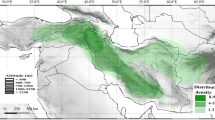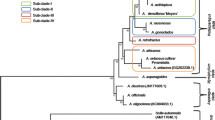Abstract
To elucidate the evolution of epiphytes in Liparis section Liparis, we examined the phylogenetic relationships of 16 species by using internal transcribed spacer regions of 18S–26S nuclear ribosomal DNA (ITS) and three chloroplast DNA regions (trnS-trnG spacer, trnL with trnL-trnF spacer, and partial matK). Results showed that the epiphytic L. fujisanensis is sister to the terrestrial L. koreana and L. kumokiri, while another epiphyte, L. truncata, is sister to the terrestrial L. krameri. Therefore, the two epiphytic species evolved from terrestrial species independently in section Liparis. Comparative seed morphology revealed that the epiphytes have larger embryos than their closely related terrestrial counterparts. A similar trend toward the increase of embryo size in the two epiphytic species belonging to closely related, but distinct clades suggests that the large embryo may have an advantage in the epiphytic lifestyle. The two epiphytic species share another character state, smaller air spaces in the seed than that of closely related terrestrial species, suggesting possible low dispersibility of the epiphytes.






Similar content being viewed by others
References
Arditti J, Ghani AKA (2000) Numerical and physical properties of orchid seeds and their biological implications (Review). New Phytol 145:367–421
Barthlott W (1976) Morphologie der Samen von Orchiden im Hinblick auf taxonomische und funktionelle Aspekte. In: Senghas K (eds) Proceedings of the 8th World orchid conference. German Orchid Society, Germany, pp 444–445
Cameron KM (2005) Leave it to the leaves: a molecular phylogenetic study of Malaxideae (Epidendroideae, Orchidaceae). Am J Bot 92:1025–1032
Chase MW, Pippen JS (1988) Seed morphology in the Oncidiinae and related subtribes (Orchidaceae). Syst Bot 13:313–323
Clifford HT, Smith WK (1969) Seed morphology and classification of Orchidaceae. Phytomorphology 19:133–139
Cribb P, Govaerts R (2005) Just how many orchids are there? In: Raynal-Roques A, Roguenant A, Prat D (eds) Proceedings of the 18th World orchid conference. France Orchidées, Dijon, pp 161–172
Garay LA, Romero-Gonzalez GA (1999) Schedulae Orchidum II. Havard Pap Bot 4:475–488
Gravendeel B, Chase MW, de Vogel EF, Roos MC, Mes Ted HM, Bachmann K (2001) Molecular phylogeny of Coelogyne (Epidendroideae; Orchidaceae) based on plastid RFLPs, matK, and nuclear ribosomal ITS sequences: evidence for polyphyly. Am J Bot 88:1915–1927
Hamilton MD (1999) Four primer pairs for the amplification of chloroplast intergenic regions with intraspecific variation. Mol Ecol 8:521–523
Hashimoto T (1987a) Our recent knowledge of the Japanese orchid flora. In: Saito K, Tanaka R (eds) Proceedings of the 12th World orchid conference. Nippon Tosyo Tsushin Hanbai, Tokyo, pp 118–126
Hashimoto T (1987b) Species Orchidacearum novae vel rariores. Bull Natl Sci Mus Tokyo Ser B 13:35–39
Huttunen S, Ignatov MS, Müller K, Quandt D (2004) Phylogeny and evolution of epiphytism in the three moss families Meteoriaceae, Brachytheciaceae, and Lembophyllaceae. In: Goffinet B, Hollowell VC, Magill R (eds) Molecular systematics of bryophytes. Missouri Botanical Garden Press, St. Loius, MO, pp 328–361
Jernstedt JA, Cutter EG, Gifford EM, Lu P (1992) Angle meristem origin and development in Selaginella martensii. Ann Bot 69:351–363
Kress WJ (1989) The systematic distribution of vascular epiphytes. In: Lüttge U (ed) Vascular plants as epiphytes. Springer, Berlin Heidelberg New York, pp 234–261
Maddison M (1977) Vascular epiphytes: their systematic occurrence and salient features. Selbyana 2:1–13
Maekawa F (1971) The wild orchids of Japan in colour (in Japanese). Seibundo-shinkousha, Tokyo
Murren CJ, Ellison AM (1998) Seed dispersal characteristics of Brassavola nodosa (Orchidaceae). Am J Bot 85:675–680
Posada D, Crandall KA (1998) Modeltest: testing the model of DNA substitution. Bioinformatics 14:817–818
Sun Y, Skinner DZ, Liang GH, Hulbert SH (1994) Phylogenetic analysis of Sorghum and related taxa using internal transcribed spacers of nuclear ribosomal DNA. Theor Appl Genet 89:26–32
Swofford DL (2002) PAUP*. Phylogenetic analysis using parsimony (* and other methods). Sinauer, Sunderland
Taberlet P, Gielly L, Pautou G, Bouver J (1991) Universal primers for amplification of three non-coding regions of chloroplast DNA. Plant Mol Biol 17:1105–1109
Thompson JD, Gibson TJ, Plewniak F, Jeanmougin F, Higgins DG (1997) The Clustal X Windows Interface: flexible strategies for multiple sequence alignment aided by quality analysis tools. Nucl Acids Res 25:4876–4882
Topik H, Yukawa T, Ito M (2005) Molecular phylogenetics of subtribe Aeridinae (Orchidaceae): insights from plastid matK and nuclear ribosomal ITS sequences. J Plant Res 118:271–284
Tsutsumi C, Kato M (2006) Evolution of epiphytes in Davalliaceae and related ferns. Bot J Linn Soc 151:495–510
Yukawa T, Koga S, Handa T (1999) DNA uncovers paraphyly of Dendrobium (Orchidaceae). In: Andrews S, Leslie AG, Alexander C (eds) Taxonomy of cultivated plants. Royal Botanic Gardens, Kew, pp 351–354
Acknowledgments
The authors thank M. Akashi, M. Goto, H. Hongo, T. Kuhara, K. Miyoshi, T. Nagai, H. Nakayama, K. Oikawa, K. Sakamoto, M. Sato, M. Takashima, and K. Watanabe for sampling and field trips. The authors are grateful to K. Suzuki who cultivated plants used in this study, M. Takashima for useful discussion, and F. Tajima for helpful advice about statistical analyses. This study was supported by a-Grant-in-Aid for Scientific Research from the Japan Society for the Promotion of Science and by the Fujiwara Natural History Foundation.
Author information
Authors and Affiliations
Corresponding author
Electronic supplementary material
Below is the link to the electronic supplementary material.
Rights and permissions
About this article
Cite this article
Tsutsumi, C., Yukawa, T., Lee, N.S. et al. Phylogeny and comparative seed morphology of epiphytic and terrestrial species of Liparis (Orchidaceae) in Japan. J Plant Res 120, 405–412 (2007). https://doi.org/10.1007/s10265-007-0077-0
Received:
Accepted:
Published:
Issue Date:
DOI: https://doi.org/10.1007/s10265-007-0077-0




